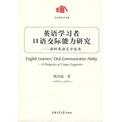英语学习者口语交际能力研究
出版时间:2009-10 出版社:上海交通大学出版社 作者:甄凤超 页数:270 字数:335000
前言
对于把英语作为外语的学习者来说,其他产出性或接受性语言能力(如写作能力、阅读能力等)的提高未必能保证口语交际能力的提高,原因是口语交际能力除了发音技巧之外,还包含使用交互策略等能力。然而,同阅读、写作以及词汇学习等研究相比,对于学习者口语的研究还较欠缺,主要是由于口语交际属于瞬息性活动,并且难以保证学习者口语交际样本数据的有效性。此外,研究者通常把研究书面语的模式应用到对口语语料的研究中。学习者英语口语语料库的开发为研究学习者的口语提供了大量真实语料。本书基于“大学学习者英语口语语料库”(College Learners’Spoken English Corpus,简称COLSEC),试图从定量和定性的角度分析中国学习者的英语口语特征。 基于前人的理论和实证研究,本书假设学习者的英语口语交际能力同他们的总体语言能力水平呈正相关,并包括以下主要成分:图式知识、语言能力、语用能力和策略能力。语言能力,作为学习者一种较为隐合的知识结构,不仅包括语音、词汇和语法知识,还包括预构成语块的知识。预构成语块作为词汇与语法的结合体,其使用更加符合口语交际的特点。此外,图式知识的测量需要精密的心理试验,本书不可能做详细考察。语料库关键词提取的方法可以考查学生部分图式知识的词语表现。因此,本书重点考察口语交际能力中的四种重要成分:使用预构成语块的能力、通过目的语运用图式知识的能力、语用能力和策略能力。主要研究问题包括:该四种能力如何影响学习者的口语交际?不同口语交际能力水平的学习者在四种能力方面的表现有何异同?学习者英语口语具有什么显著特征?本书采取分层随机抽样的方法,从COLSEC中提出150名学习者的英语口语语料,并按照大学英语考试口语成绩的高低将他们分为A、B和C三组,分别代表三种不同的口语交际能力水平。本书重点考察三组学习者在四个能力方面的异同,进而发现他们的英语口语特征。
内容概要
本书从语料库语言学角度,着重探讨了中国学习者英语口语交际能力的四个重要成分:使用预构成语块的能力、通过目的语运用图式知识的能力、语用能力和策略能力。基于“大学学习者英语口语语料库”,本书从上述四个纬度对比分析了不同口语交际能力水平的学习者之间及与英语母语者之间的差异,发现中国学习者英语口语的特征和问题。书中所提出的观点、概念、方法以及研究发现为学习者英语研究、二语习得研究、外语教学研究提供了有价值的信息。
书籍目录
Chapter 1 Introduction 1.1 Motivations for the book 1.2 Research objectives 1.3 Outline of the bookChapter 2 Critical Discussion of the Previous Studies on Learner Language 2.1 Changes in current linguistic and SLA research 2.2 Main features of CLC data 2.3 Methodological approaches to CLC research 2.4 Studies based on learner corpora 2.5 Conversation analysis 2.6 Communicative competence 2.7 ConclusionChapter 3 Defining Oral Communicative Ability 3.1 Features of oral communication 3.2 Accuracy, fluency and appropriacy 3.3 Four essential components 3.4 ConclusionChapter 4 Research Methodology 4.1 The COLSEC 4.2 The data in the book 4.3 Methods for data extraction and processing 4.4 SummaryChapter 5 Findings and Analysis (1):Productive Vocabulary Size and the Ability to Use PCsChapter 6 Findings and Analysis (2):the Ability to Manipulate SchemataChapter 7 Findings and Analysis (3):Pragmatic Competence and Strategic CompetenceChapter 8 ConclusionAppendicesReferences
章节摘录
Another example is An Automated Approach to the Phrasicon of EEL Learners by Cock, Granger, Leech&McEnery (1998). It is commonly observed that although the language produced by advanced learners is largely free of errors, it remains foreign sounding. A reasonable hypothesis made by Kjellmer (1991) is that in learners production the building material is individual bricks (words) rather than prefabricated sections (lexicalized phrases). In other words, the learners primarily operate on the "open-choice principle" rather than the "idiom principle" (Sinclair, 1991). There is a growing consensus among many researchers that prefabricated expressions rather than individual words play a predominant role in the production of both written and spoken language. NSs heavily rely on prefabs particularly in oral production unfolding in real time. As Granger (1998) puts it, "this reliance allows speakers to play for time, enabling them to speak without too much hesitation or too many pauses and consequently to avoid too much non-fluency" (p. 67). Cock et al. (1998) use a matched set of 25 transcribed learner (French) and NS university admission interviews to examine the spoken phrasicon of adult advanced EFL learners to validate Kjellmer s hypothesis. They use McEnery s automatic phrase extraction program Tuples to extract all recurrent word combinations of a given length and frequency in the two corpora. Tuples output is thus two long lists of all the recurrent phrases in the two corpora accompanied by counts and basic statistics. This study reveals a striking finding that these advanced EFL learners of French MT do use prefabs, and in some cases even more prefabs than English NS. This finding to some extent goes against Kjellmer s hypothesis. However, what distinguishes the learners from the NSs is the small number of prefabs these learners have at their disposal and the extent to which these prefabs are used and overused.
图书封面
评论、评分、阅读与下载
用户评论 (总计0条)
相关图书
- 急性化学损伤应急救援与救治
- 孤鹜落霞
- 制胜新托福写作
- 也是历史
- 2010年全国会计专业技术资格考试辅导用书
- 卡通动漫屋3
- 酷警天兵01
- 酷警天兵02
- 酷警天兵03
- 酷警天兵04
- 中国国家标准汇编 399 GB22521~22576
- 中国国家标准汇编 409 GB23147~23201
- 中国国家标准汇编
- 中国国家标准汇编396 GB22423~22456
- 中国国家标准汇编 402 GB 22670~22707
- 中国国家标准汇编2008年修订-3
- 中国国家标准汇编 410 GB 23202~23209
- 公司治理学
- 财务管理
- 会计概论
- 稳固基础-无敌高中英语词汇特训-1
- 十字路口的中国经济
- 社会工作行政
- 中国社会工作相关政策法规汇编
- 社会福利行业和职业标准
